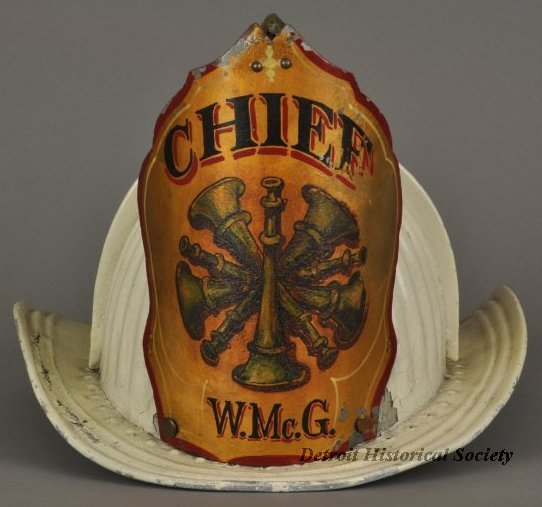For the first century of its existence, the City of Detroit did not have an official fire department. In the early 1800s, the frontier town of Detroit was made up of crammed-together wooden homes and businesses and used a bucket brigade system to fight fires. Citizens would line up between the fire and the Detroit River and quickly pass buckets of water to slow the blaze. With the city’s expanding boundaries, this process became unreliable and inefficient. The first attempt to control fires was an 1802 ordinance requiring that chimneys be swept and that households maintain a barrel with “ears” (handles for carrying it between two men over a pole) filled with water for any fire exigency, but wasn’t rigorously enforced.
The infamous 1805 fire, a blaze that started on June 11 in a baker’s stable, proved the bucket brigade useless at putting out the conflagration. After Detroit was rebuilt by its citizens, a serious attempt at organizing fire fighters began with the purchase of an engine in 1816 and the formation of volunteer squads.
As the city grew, volunteer fire companies organized to protect neighborhoods. The men were required to have their own equipment, though the city provided hand-operated pumping engines. Fire halls were the bases for these volunteers, where balls, parades and other social events were held. Though the dashing garb of these early firefighters made them something of an elite group, they were unorganized and essentially undisciplined social clubs.
In 1860, the city of Detroit finally hired its first paid firefighters including one engineer, five horsemen, two drivers, and a foreman to operate the first steam fire engine, named “Lafayette No. 1.” The steam pump was housed at the northeast corner of Larned and Wayne streets, was capable of pumping 600 gallons of water per minute, and was pulled by two horses. The following year the fire department purchased two more steam engines that they named “Neptune No. 2” and “Phoenix No. 3.” The Board of Fire Commissioners was established in 1867 to oversee the fire department. In 1892, the city purchased its first fireboat, the Detroiter. By 1902, the wooden boat had begun to rot and the equipment was transferred to a new steel-hulled fireboat named the James R. Elliot, after Detroit’s second fire chief.
By 1900, Detroit’s population had increased to just under 300,000, and the fire department grew to 476 paid firemen, one fire boat, 423 fire boxes, 3,609 fire hydrants, and 76 pieces of horse drawn equipment. As the world transitioned to motorized vehicles, the fire department reluctantly switched over to the motorized fire engines, manufactured by the Packard Motor Company. On April 10, 1922, more than 50,000 people lined Woodward Avenue to witness the horses’ ceremonial last run to an arranged false alarm at the National Bank Building. The five horses, named Pete, Jim, Tom, Babe, and Rusty, were then retired to Rouge Park. The Horse Bureau had existed since 1886.
Other major events in the history of the Detroit Fire Department include: the hiring of its first black member, Alfred J. Brown in 1894, to be followed much later by Marcena W. Taylor and Marvin White in 1938; the banishment of stations’ dog mascots in 1976 because of possible liability due to dog bites; and the hiring of the first women firefighters, Harriett Saunders, Sandy Kupper, and Theresa Smith in 1977. The first African American fire chief was Harold Watkins in 1988.
Today the Detroit Fire Department has eight divisions that range from firefighting to community relations. The firefighting division consists of approximately 821 firefighters housed in 46 strategic locations throughout the city.
